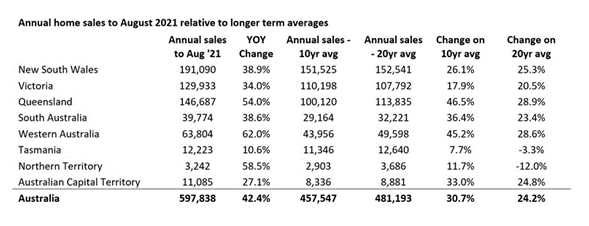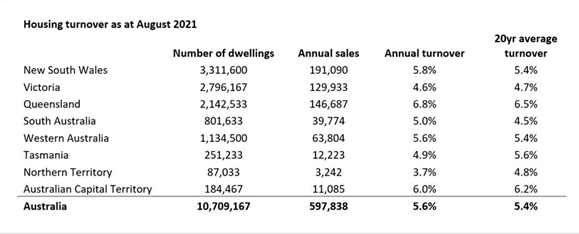

CoreLogic reported a total of 598,000 house and unit sales across Australia ending August, making it the highest number of annual sales since 2004.
Despite the onset of the pandemic, the number of houses sold over the past year was 31% above the decade average and 24% higher than the 20-year average.
Every state except Tasmania saw more than a 10% lift in its year-on-year home sales. However, CoreLogic noted that Tasmania’s smaller increase in sales was due to a lack of supply rather than a shortage of demand.
Previously identified weak markets Western Australia and Northern Territory have caught up to be the largest year-on-year increase in sales at 62% and 58.5%, respectively. Queensland takes the third spot at 54%.
“Such a significant surge in housing demand may seem surprising at a time when overseas migration has stalled. However, the substantial rise in home sales can be explained by a lift in domestic demand from previously low levels,” said Tim Lawless, research director at CoreLogic.
Across the states, turnover was highest in Queensland at 6.8%, where housing prices are relatively more affordable than New South Wales and Victoria. Other top performers are the Australian Capital Territory at 6% and New South Wales at 5.8%.

But it wasn’t always like this. In 2015, housing turnover began to decline as credit conditions tightened, transaction costs grew more expensive, and overall affordability slowly became out of reach. Turnover hit a record low in June 2019 when only 3.7% of homes transacted over the year.
The government carried out more incentives such as stamp duty concessions and deposit guarantees to entice more Australians to participate in the housing market. On top of that, credit conditions loosened and mortgage rates dwindled.
By the end of August, housing turnover had risen to 5.6%– the highest rate since December 2009.
If mortgage rates remain at record lows while economic conditions improve, then states across Australia can expect an even higher housing turnout by the time 2022 rolls in.
“Housing turnover is likely to increase a little further from here, considering the annual number of sales is yet to peak. However, over the medium term, we expect turnover is likely to peak in early 2022,” Lawless said. “There is already evidence the monthly number of home sales is starting to ease, although reading through the additional disruption of lockdowns makes the trends harder to interpret.”
